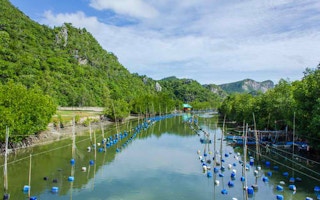Surakit Laeaddee walks along the narrow banks of earth dividing his organic shrimp and fish ponds, rests under the shade of a tree he recently planted, and points to the lush mangroves marking out his plot.
Too many trees invite birds that prey on his seafood stock. But planting just enough, on a fifth of his 10 hectares (24 acres), cools the ponds and improves soil and water quality, boosting the health, reproduction and survival of his shrimp and fish.
“I hope the community will become more conscious about the importance of planting trees and looking after the ecosystem in order to raise seafood sustainably and prevent coastal erosion,” he said, looking toward the Gulf of Thailand, which has gnawed away at the shore, bringing the sea ever closer to his home.
Since the 1980s, a boom in shrimp farming has decimated mangroves around the world.
The trend has destroyed a key ecosystem for carbon storage, added to emissions of planet-warming carbon dioxide, and exposed shorelines and communities to storm surges and erosion.
Now, growing consumer demand for organic and sustainable foods has spurred interest in shrimp farms like Surakit’s that may stem mangrove loss and encourage planting in areas long devoid of trees.
“A shift from intensive farming to more natural farming is more sustainable in the long run,” said Supranee Kampongsun, mangroves and markets project coordinator for the International Union for Conservation of Nature (IUCN).
“It gives marine species natural spawning grounds and improves the mangrove ecosystem. If individual farmers consider having trees on their land, it will contribute to a growth in overall coverage in the area.”
Land grabs and investors
A 1961 survey along Thailand’s 3,100 km (1,900 mile)coastline tallied 368,000 hectares of mangrove forests, which include more than 70 tree species - from typical mangroves hovering above water with buttressed roots to giant nipa palms.
Over half a century, a third of that area has been lost, leaving 246,000 hectares, according to the Department of Marine and Coastal Resources. About 70,000 hectares are used for seafood farms, mostly shrimp.
Similar declines have been documented across Asia and Latin America. A 2012 UN-backed study found a fifth of mangroves worldwide had been lost since 1980, mostly for intensive shrimp farms that often become choked with waste, antibiotics and fertilisers.
In Thailand, the destruction of mangroves for shrimp levelled off about 10 years ago, but the government is struggling to restore the barren lands, said Somsak Piriyayota, director of the mangrove resource conservation office.
“The issue today is how do we change that land for shrimp back into mangroves,” Somsak said in an interview, noting some mangroves have been inhabited by communities for generations.
“We’ve never been strict. The policy has allowed for them to live there, but the ecosystem is deteriorating, so we have to solve this problem, yet we have to give them the right to a livelihood as well.”
A key challenge is sorting out real land ownership from profit-driven land grabbing.
“We have a government policy to reclaim forests - from investors, but not from poor people. With shrimp farmers, it’s generally investors,” Somsak said.
A new mixed land-use policy will allow communities in southern Nakhon Sri Thammarat province to use degraded mangroves for income, on the condition that half the area is maintained as mangroves or converted back to them, he said.
Healthy and sustainable
Once the leading exporter of shrimp, Thailand has been hit hard in the past few years by a deadly disease called early mortality syndrome that wiped out shrimp populations, as well as by widespread reports of migrant labour rights abuses.
The government and seafood industry have scrambled to bring in measures to clean up labour violations in their supply chains.
On the farming front, the Thai Department of Fisheries is encouraging more environment-friendly production systems to avoid disease and decrease pollution.
That includes planting trees to act as a filtration system, using natural rather than artificial feed, and steering clear of pesticides, fungicides and antibiotics.
The IUCN is working with shrimp farmers in Thailand, Vietnam and Bangladesh to restore mangroves and use them sustainably. With support from the conservation agency, farmers like Surakit are sharing best practices with their neighbours and across the country.
Surakit’s marine shrimp farm is among the first to be certified organic by the Thai government.
Fifteen other farmers living nearby are on track to be certified this year, which would increase the organic shrimp farming area in the community tenfold, to almost 100 hectares.
Organic yields are much lower, but each shrimp grows much larger. Surakit says he raises two to five shrimp per square metre, compared to 20 to 30 per square metre on intensive farms.
His organic shrimp sell at a higher price - up to $27 per kg, compared to $14 per kg for the largest shrimp from an intensive farm.
Furthermore, input costs are lower, and organic ponds have a longer lifespan than intensively farmed ponds, which often become so overrun by disease and pollution they are abandoned.
The plush JW Marriott Hotel in Bangkok buys shrimp from Surakit. In Vietnam, where the IUCN piloted its mangroves and markets programme, more than 700 farmers are certified organic and selling to European markets.
“Mangroves are a supermarket for humans,” said Somsak of the mangrove conservation office, describing a food chain from leaves and parasites to crabs, fish and humans.
“The main producer is the trees, and everyone else is in the chain of consumers. When humans cut the trees, it’s the end. The food chain is broken.”










